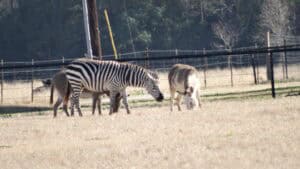
Our local zebra in the pasture with friends.
Of all the things you might expect to see in Texas, Zebras aren’t at the top of the list. In fact, they don’t even make the list. Yet, there’s a Zebra living on a local farm not far from me, and since yesterday was National Zebra Day, I decided to share some interesting facts about this exotic animal.
The Basics
Everyone knows what a zebra looks like. It’s one of the most recognized animals in the world. Most people think of it as a horse with black and white stripes, but this native-African creature, while in the same equine species as horses and donkeys, should not be thought of as a horse. Having evolved with African predators, its fight-or-flight instinct is too strong and its temperament too unpredictable to be domesticated.
There are three different zebra species: Plains Zebra, Mountain Zebra, and Grévy Zebra (aka, Imperial Zebra). They are herbivores and are constantly on the move to find water and food (plants, grasses, and roots).
If predators don’t get them, and they find sufficient food and water, wild zebras will live about 25 years. In a zoo, zebras can live for up to 50 years.
Did You Know…
- 60-80% of a zebra’s life is spent eating.
- Zebras will travel hundreds of miles to find food and water. They have amazing memories. They not only remember past migratory routes, but which routes had more available food and water.
- To release stress, a zebra will shake its entire body, then go back to eating.
- Zebras generally sleep standing up, but they can sleep lying down when in a herd.
- A zebra’s pregnancy ranges from 12-14 months.
- After birth, a zebra foal is able to stand within six minutes, walk within twenty minutes, and run within forty minutes.
- A mother zebra keeps her newborn foal away from other zebras for two or three days. She wants to make sure her foal recognizes her smells, stripes, and voice.
- The offspring of a horse and a zebra is called a zebroid.
Traits and Characteristics
Zebras are very social animals. They live in tight family groups. Each single male has a haram of multiple females and children. Usually, 5-20 zebra families travel together, but there can be as many as 1,000 individual zebras in the whole group.
A group makes it easier to spot predators and protect the sick and young, but zebras also have an abundance of survival skills. Thanks to excellent eyesight, they can see danger coming, especially at dawn and dusk when predators are likely to strike. They also have exceptional senses of hearing and smell. And because they are strong, fast runners and swimmers, they can escape when predators threaten. If they can’t run from danger, they will stand and fight. Their kick—almost 3,000 pounds of force—is hard enough to severely injure or kill an adult lion.
Did You Know…
- A group of zebras is known as a dazzle, a zeal, or a herd.
- Zebras communicate through sounds (vocalizations), body and ear movements, and facial expressions.
- Zebras have a nearly 360-degree view, but their color vision is limited to shades of blues and greens. They cannot distinguish orange.
- A zebra not only can rotate its ears 180 degrees, but it can move each ear independently of the other. This allows it to pinpoint exactly from where a sound is coming.
- Due to its strong sense of smell, zebras can locate water even during droughts.
- Zebras can use their powerful hooves to dig holes and find water below the ground.
- A zebra can survive for up to five days without drinking water.
- To make it difficult for predators to catch them, zebras run in a zig-zag pattern.
- A zebra can run up to 40 miles per hour, meaning it can outrun most predators.
- Mountain zebras are remarkable climbers.
The Stripes
The stripes are what make a zebra so memorable. But they are more than just a pretty, uniquely-colored coat. The stripes protect the zebra in three distinct ways.
- Protection from the strong African sun. The melanin contained in the black stripes is a natural sun protectant, absorbing the sun’s harmful UV rays, while the white stripes reflect sunlight. This combination creates air currents that cool the zebra, regulating its body temperature.
- Provide camouflage from dangerous animals. The black and white stripes create a visual illusion—called “motion dazzle”—which makes it difficult for predators to single out an individual zebra.
- Provide pest control. Because flies and other biting insects find it harder to land on striped surfaces, the stripes act as an insect repellent.
Though all zebras have a black base color—the white stripes develop later, meaning a zebra is black with white stripes—the width and pattern of each species’ stripes is unique to that species.
Did You Know…
- Each zebra species’ stripes gets wider the further south you travel on the African continent.
- A zebra’s stripes are like human fingerprints. No two stripe patterns are the same, even in the same species. Zebras recognize other zebras by their unique stripes.
- Individual zebras can be scanned and identified by scientists who “read” their stripes just like reading a barcode.
- There are golden zebras. These zebras have white skin and golden stripes because they lack melanin for producing dark pigmentation.
Endangered Animals
The International Union for Conservation of Nature (IUCN) lists all zebra species as endangered. The continuing loss of their habitats to agriculture and urbanization, competition with livestock for grazing lands, droughts, natural predators, the lack of genetic diversity, and, of course, poachers, have brought zebras to the brink of extinction.
Today only around 2,000 Grévy’s zebras are left. The population of the mountain zebras is about 35,000, but it continues to decrease. As does the plains zebras. They may be the largest group, but they only have a population in the wild of 150,000-250,000.
Did You Know…
- Zebras in Roman circuses were usually called “Tiger-Horses” or “Horse-Tigers.”
- Zebras symbolize freedom and beauty in African cultures. In Western culture, zebras are symbols of exotic beauty and even humor.


Enjoyed the DYK.
Just this morning, a preacher was telling his church about his recent trip to Johannasburg, Africa. He had photos of animals, one of which was a zebra. He just commented that in Africa, it is referred to as a mule in pajamas. It kinda does look that way!
Glad you enjoyed the DYK. I like the “mule in pajamas” description. That’s great!